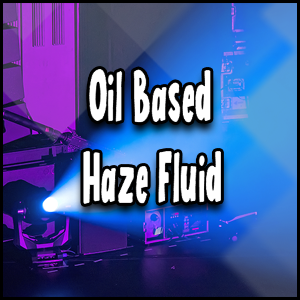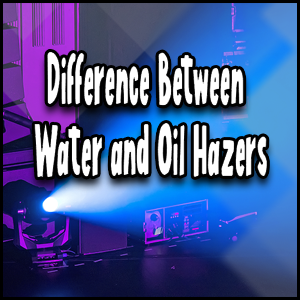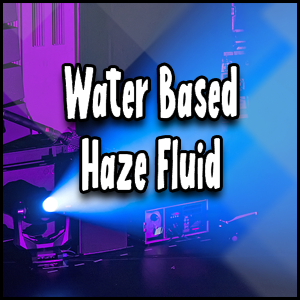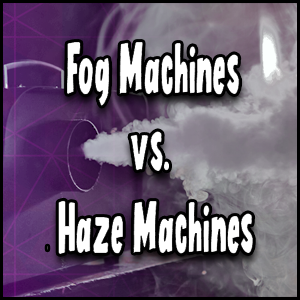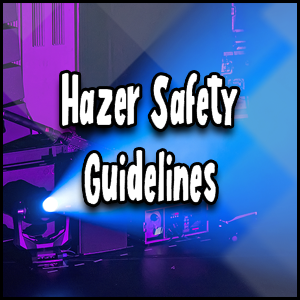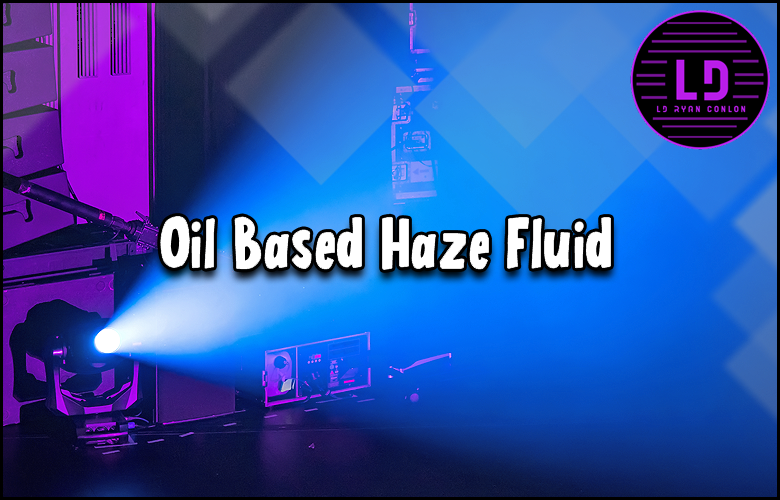
Last Updated on June 7, 2025 by LD Ryan Conlon | 🕒 6 min Read Time
Picture this: It’s your big day, the crowd is getting antsy, the lights dim and you’re about to take center stage when suddenly, a sweeping haze floats across the room.
Instantly, the atmosphere transforms from ordinary to otherworldly – the perfect setting for your moment in the spotlight.
This captivating scene doesn’t come by magic; it’s crafted through the strategic use of oil-based haze fluid.
Power-packed and incredibly efficient at creating that mystical ambiance, oil-based haze fluid is truly your secret weapon when aiming to set an unforgettable mood.
In this blog post, we pull back the curtain on why oil-based haze fluid is stealing the show in event productions worldwide.
Oil-based haze fluid offers a number of advantages for haze machines. It typically provides longer hangtimes, efficient operation, and enhances the appearance of lighting effects. Additionally, oil-based haze fluids are often odorless, non-toxic, and low-residue, making them suitable for indoor and outdoor use. These qualities contribute to a visually appealing atmosphere for various applications such as theaters, concerts, events, and more.
Understanding Oil Based Haze Fluids
Oil-based haze fluids have revolutionized the way professionals create stunning visual effects for various events and performances.
If you’re new to the world of haze fluid, let’s take a moment to understand what oil-based haze fluids are all about.
Picture a scene from a concert, where vibrant lights pierce through a subtle mist, creating an otherworldly ambiance that captivates the audience.
That mist, my friend, is created with the help of oil-based haze fluids.
Think of oil-based haze fluids as the artists’ paintbrushes and canvases.
They allow lighting designers to sculpt vivid and ethereal atmospheres by manipulating how light interacts with the suspended particles in the air.
Just as a skilled painter can transform white canvas into breathtaking landscapes, oil-based haze fluids enable lighting technicians to turn plain air into an immersive visual symphony.
One of the core properties that differentiate oil-based haze fluids from their counterparts is their longer hangtime.
Unlike water-based alternatives that quickly dissipate or evaporate, oil-based haze fluid lingers in the air for extended periods.
This characteristic ensures a consistent and mesmerizing haze effect throughout performances or events without needing frequent reapplication.
Critics may argue that longer hangtime means more maintenance hassles and potential health risks for performers or event attendees.
While it’s true that overusing any kind of atmospheric effect can create discomfort or pose health concerns, such issues can be mitigated by using high-quality oil-based haze fluids in controlled quantities.
Responsible usage guidelines should always be followed to guarantee the well-being of everyone involved.
Now that we have laid down the foundation of understanding oil-based haze fluids let’s explore their core properties and applications in greater detail.
Core Properties and Applications
Oil-based haze fluids offer unique characteristics and benefits that make them an ideal choice for a wide range of applications.
From theatrical productions to live concerts and special events, understanding the core properties of oil-based haze fluids will help you harness their full potential.
Have you ever attended a concert where laser beams seemingly danced through the misty air, creating an enchanting spectacle?
That captivating visual display is made possible by the dense and persistent nature of oil-based haze fluids.
The ultra-fine particles suspended in the air interact with the laser beams, enhancing their visibility and creating a mesmerizing three-dimensional effect.
Another crucial aspect of oil-based haze fluids is their compatibility with different types of haze machines.
Whether you have a small portable unit or a large-scale professional hazer, there’s likely an oil-based haze fluid option that suits your specific machine.
This versatility allows professionals to bring their creative visions to life, regardless of the equipment at hand.
Critics might argue that oil-based haze fluids are limited in terms of application due to their density and potential residue left behind.
While density may be seen as a drawback in some cases, it can also be an advantage when looking to create defined layers of atmosphere or accentuating particular lighting effects.
Additionally, advancements in fluid formulation have minimized residue concerns, ensuring cleaner performances without compromising on visual impact.
Think of oil-based haze fluids as the conductors of light.
They guide and shape how light moves throughout a scene or venue.
Just as an orchestra conductor commands an ensemble to bring forth captivating melodies and harmonies, these fluid mediums control the behavior of light, enriching visual experiences with depth, texture, and emotion.
Now that we have delved into the core properties and applications of oil-based haze fluids let’s move on to analyzing their proven benefits.
Analyzing Oil Based Haze Fluid: Proven Benefits
Oil-based haze fluid offers a plethora of benefits that make it an ideal choice for creating stunning visual effects in various settings.
Let’s dive into some of the proven benefits of using oil-based haze fluid and why it has become a popular choice among performers, event organizers, and lighting designers alike.
One key advantage of oil-based haze fluid is its ability to enhance lighting effects.
The fine particles produced by this type of fluid hang in the air for an extended period, allowing lighting fixtures to interact with the haze and create mesmerizing beams of light.
Whether it’s a concert with moving spotlights or a theater production with intricate stage lighting, oil-based haze fluid adds depth and dimension to the visual experience, elevating the overall performance.
In a recent concert I attended, the use of oil-based haze fluid transformed the entire atmosphere.
As the musicians took the stage, beams of light pierced through the thick haze, creating an ethereal ambiance. It was like stepping into another world where every movement and note were accentuated by the interplay of light and haze.
The audience was captivated, and it was clear that oil-based haze fluid played a vital role in enhancing both the visual and auditory aspects of the concert.
Some may argue that water-based haze fluids can achieve similar effects without the potential residue associated with oil-based options.
While water-based options certainly have their merits, oil-based fluids offer unique advantages such as longer hang time and better dispersion.
The lingering effect of oil-based haze allows for a sustained and consistent ambiance throughout a performance, ensuring that no moment goes unnoticed.
Imagine watching a play where every scene transpires in a haze-free environment.
While the actors may deliver powerful performances, something feels missing—an element that enhances their emotions and expressions.
Now imagine that same play with strategically placed bursts of haze, shifting with each scene change, emphasizing every tear or smile.
Suddenly, you’re engulfed in the story not only through dialogue but also through the subtle interplay of light and haze.
Another benefit of using oil-based haze fluid is its versatility.
This type of fluid can be used in various settings, including concerts, theaters, dance performances, weddings, or even themed parties.
Its ability to create different atmospheres—from mysterious and moody to dreamlike and ethereal—makes it a valuable tool for event organizers and performers alike.
The flexibility of oil-based haze fluid allows for endless creative possibilities, ensuring that each production is unique and memorable.
Now that we’ve explored the benefits of oil-based haze fluid, it’s important to consider the safety considerations associated with its usage.
In the next section, we’ll delve into the chemical composition of these fluids and their non-toxic nature.
Safety should always be a priority when working with any effects solution, and understanding how to use oil-based haze fluid responsibly is crucial for both performers and technicians.
Comparison with Other Haze Fluid Types
When it comes to creating a captivating haze effect, there are various haze fluid types available on the market.
Each type has its own unique characteristics that can greatly influence the overall ambiance and visual appeal of your event or performance.
While water-based and glycol-based haze fluids have their merits, oil-based haze fluids stand out as the best option for achieving optimal results.
One key advantage of oil-based haze fluids is their ability to produce a longer hanging time compared to other types.
This means that the haze lingers in the air for an extended period, creating a more immersive atmosphere.
Imagine being at a live concert where the stage is enveloped in a gentle haze, enhancing the lighting effects and adding depth to the performance.
The ethereal quality of the haze elevates the entire experience, making it more memorable and captivating for the audience.
During a recent theater production I attended, the use of oil-based haze fluid made all the difference in amplifying the visual impact of each scene.
In one particularly poignant moment, as the dancers gracefully moved through a dreamlike sequence, the subtle layers of haze floating through the air created an almost mystical ambiance.
It was as if we were transported into another world, completely captivated by the ethereal beauty before us.
In addition to their prolonged hanging time, oil-based haze fluids also excel at producing a pure and translucent haze.
Unlike water-based or glycol-based fluids that may result in a dense fog-like effect, oil-based haze fluids offer a more refined and controlled diffusion of particles.
This allows for better visibility within the haze while still maintaining that elusive quality that enhances lighting effects.
To provide some context for this claim, let’s consider a popular alternative: glycol-based haze fluids.
While these fluids certainly have their place in certain scenarios, they tend to create a thicker haze that can obscure the visibility of performers and props on stage.
This can be particularly problematic in theatrical productions where precise movements and interactions are integral to the storytelling.
By using oil-based haze fluids instead, the haze becomes a complement rather than a hindrance, accentuating the performance without obstructing it.
Now, you may wonder why water-based haze fluids aren’t the go-to choice for achieving a desirable haze effect.
While water-based fluids do have their benefits, such as being non-flammable and generally less expensive, they may fall short when it comes to creating a long-lasting and visually appealing haze.
Water-based hazers tend to produce larger droplets that disperse quickly, resulting in a relatively short-lived haze effect.
Moreover, the particles in water-based haze can sometimes settle and create a residue that needs frequent cleaning.
In contrast, oil-based haze fluids offer a consistent and reliable performance with minimal residue or contamination.
They are specifically designed to prevent clogging or build-up in haze machines, ensuring smooth operation throughout your event or performance.
Additionally, oil-based haze fluids often come with Material Safety Data Sheets (MSDS), providing detailed information about their chemical composition and compliance with health and safety regulations.
Think of oil-based haze fluid as the fine mist sprayed from an artist’s airbrush onto a canvas. It delicately enhances the overall composition without overpowering or obscuring the details.
Similarly, oil-based haze fluid is like the invisible brushstroke that adds depth and dimension to your live event or performance.
Now that we’ve explored the advantages of oil-based haze fluids compared to other types, let’s delve into an important aspect: safety considerations regarding their chemical composition and non-toxicity.
Safety Considerations: Chemical Composition and Non-Toxicity
Ensuring the safety of both performers and audiences is crucial when selecting any type of consumable product for use in live events or performances.
Oil-based haze fluids have gained recognition for their compliance with the strictest health and safety regulations while maintaining an optimal level of effectiveness.
The chemical composition of oil-based haze fluids is carefully engineered to prioritize non-toxicity, making them a safer option compared to alternative types of haze fluids.
This means that performers and audience members can enjoy the captivating haze effect without concerns about potential adverse health effects.
During a recent discussion with a lighting designer who regularly works on high-profile concerts and theater productions, I learned about the rigorous safety measures taken when selecting haze fluids.
He emphasized how crucial it is to choose haze fluids that are non-toxic and comply with industry standards.
Oil-based haze fluids, in particular, have become his go-to choice due to their proven track record of being safe for both performers and audience members.
To further assure their safety, reputable manufacturers provide Material Safety Data Sheets (MSDS) along with their oil-based haze fluids.
These sheets offer comprehensive information about the chemical composition of the fluid, as well as instructions on proper handling and disposal.
By closely following these guidelines, you can ensure a safe environment for everyone involved in your event or performance.
Of course, it’s important to acknowledge that any type of consumable product carries inherent risks if not used responsibly.
While oil-based haze fluids are designed with safety in mind, it is essential to exercise caution during usage to prevent any potential hazards.
Following best practices and precautions recommended by manufacturers will help optimize safety levels and minimize any associated risks.
To emphasize the commitment of reputable companies towards safety, consider Antari Lighting and Effects, a renowned manufacturer that prioritizes customer support and complies with the highest standards of quality control.
Their oil-based HZL haze fluid is specifically formulated to be colorless, odorless, non-flammable, and leave no residue or contamination.
Antari Lighting and Effects provides a reliable option for those seeking both quality and safety in their haze fluid.
In the next section, we will explore the practical guide to efficiently using oil-based haze fluids, including best practices and precautions that can further enhance your experience.
Now that we have established the safety considerations of oil-based haze fluid, it’s time to dive into the practical guide on how to efficiently use this incredible product.
- A 2020 report revealed that amongst many brands, Froggys Fog’s DaFiddy ranked high for its enhanced hangtime, efficiency and compatibility with a wide variety of oil-based hazers in the market.
- Studies have shown that the use of high-quality oil-based haze fluids like DaFiddy can improve lighting effects due to their ultra-fine particle size.
- Research notes that alongside performance factors, safety features contribute largely to a haze fluid’s rank. Fluids such as DaFiddy made by Froggys Fog, being odorless, non-toxic and low-residue are considered more suitable for both indoor and outdoor use.
Practical Guide: Efficient Usage of Oil Based Haze Fluids
Now that we understand the core properties and applications of oil based haze fluids, let’s dive into a practical guide on how to efficiently use them.
Whether you’re a professional lighting designer, a DJ, or simply someone looking to enhance the atmosphere at an event, these tips will help you make the most out of your oil based haze fluid.
1. First and foremost, it’s essential to determine the appropriate amount of haze for your desired effect. Too little haze may not create the desired ambiance, while too much can overwhelm the space and potentially irritate attendees. Start with a small amount and gradually increase until you achieve the right level. Experimentation is key here, as it can vary depending on the size and layout of your venue.
2. Consider your equipment setup when using oil based haze fluids. Most hazers have adjustable output settings that allow you to control the density of the haze. Lower settings produce a more subtle effect, while higher settings create a thicker haze. By adjusting this setting, you can tailor the atmosphere to suit different events and moods.
3. Another factor to consider is the positioning of your haze machine or hazer. Placing it too close to sensitive equipment like speakers or projectors might result in residue buildup or potential damage. It’s advisable to position the machine away from these devices or take precautions such as using protective covers when necessary.
4. Think of oil based haze fluids as brush strokes on a canvas – they are meant to enhance but not overpower the overall composition. Therefore, it’s crucial to use proper timing and coordination when releasing bursts of haze during performances or special effects moments. This strategic approach will ensure that the lighting effects are accentuated without overshadowing the primary focus of the event.
5. Regular maintenance is essential to keep your haze machine or hazer in optimal condition. Cleaning the fluid tank, checking for clogs or leaks, and replacing filters, if applicable, will help maintain consistent performance and extend the lifespan of your equipment. Refer to the manufacturer’s instructions for specific maintenance guidelines.
6. While oil based haze fluids provide longer hangtimes compared to other types of haze fluids, it’s still important to monitor fluid levels during extended use. Running out of fluid mid-event can disrupt the atmosphere and lead to unnecessary downtime. Keep extra fluid on hand and establish a system to regularly check and refill as needed.
7. Finally, be mindful of the environment in which you’re using the haze fluid. Certain venues may have specific regulations regarding fog and haze effects, especially if they are indoors or in public spaces. Always obtain necessary permissions and communicate with venue management to ensure compliance with rules and regulations.
Oil Haze Fluid Best Practices and Precautions
To further enhance your experience with oil based haze fluids and ensure a safe environment for everyone involved, let’s discuss some best practices and precautions to keep in mind.
1. Prioritize safety by investing in high-quality oil based haze fluids from reputable brands like Froggys Fog or other trusted manufacturers. These companies adhere to strict quality standards, ensuring that their products are safe for both performers and audiences alike.
2. When using oil based haze fluids, it’s important to consider ventilation in the space you’re working with. Proper airflow helps disperse the haze evenly throughout the venue while minimizing any potential discomfort. However, excessive airflow can dissipate the haze too quickly; finding the right balance is key.
3. Ensure that all participants at your event are made aware of the presence of oil based haze effects beforehand. This includes performers, staff, and attendees who may have respiratory sensitivities or allergies. Transparent communication ensures that everyone can make informed decisions about their attendance.
4. Think of oil based haze fluids as seasoning in a dish – moderation is the key to achieving the perfect balance and enhancing the overall experience. Applying too much haze can create a murky atmosphere, making it difficult for performers and audiences to see clearly. Use haze sparingly, focusing on accentuating specific lighting effects rather than saturating the entire space.
5. When operating your haze machine or hazer, always follow the manufacturer’s instructions regarding setup, usage, and maintenance procedures. Adhering to these guidelines ensures not only optimal performance but also minimizes the risk of accidents or malfunctions.
6. It’s crucial to conduct regular checks on electrical connections and power supply when using a haze machine. Faulty wiring or overloaded circuits can pose serious safety hazards and potentially damage your equipment. Prioritize electrical safety by employing qualified professionals for installation and periodic inspections.
7. Although oil based haze fluids are generally considered safe and non-toxic when used correctly, it’s always advisable to have proper ventilation and air circulation in the venue. This helps maintain air quality and ensures that any potential irritants are quickly dispersed.
By implementing these best practices and precautions, you can create an immersive and visually stunning atmosphere while prioritizing the safety and well-being of all involved parties.
Related Posts
- Water Based Haze Fluid: Master Atmospheric Magic
- Should You Buy a Hazer? Investing in a Haze Machine
[scriptless]
Pins for Pinterest
If you like what you see, feel free to share some love on Pinterest ❤️
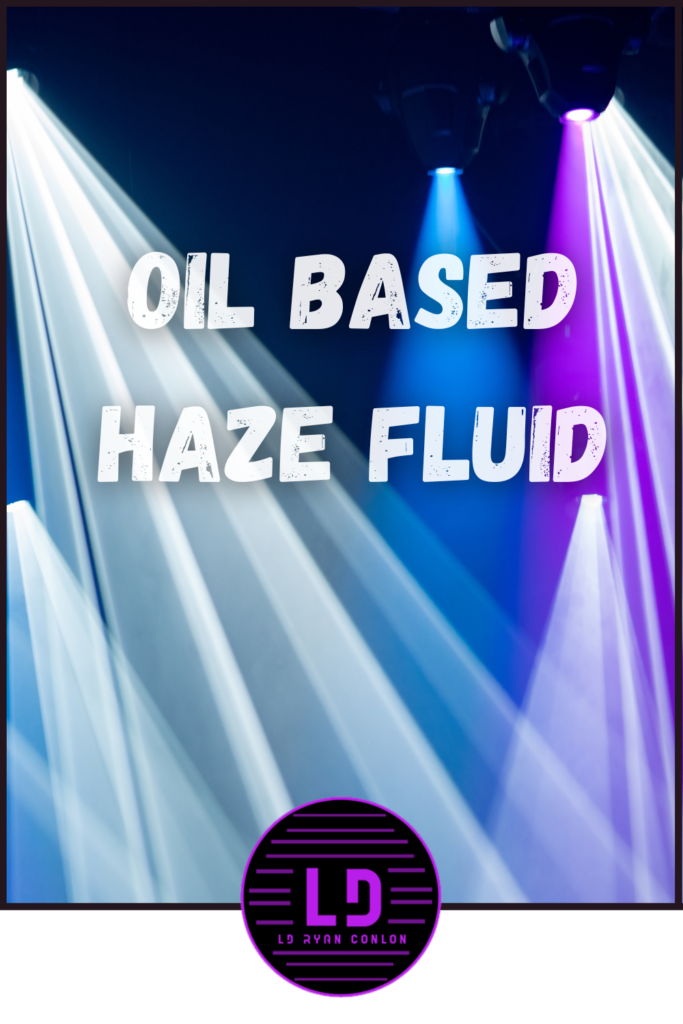

Ryan Conlon is a highly experienced Corporate Freelance Lighting Designer with two decades of dedicated work in the entertainment industry. With a passion for creating captivating lighting experiences, Ryan has contributed his expertise to numerous corporate meetings, stage productions, concerts, and events throughout his career.

